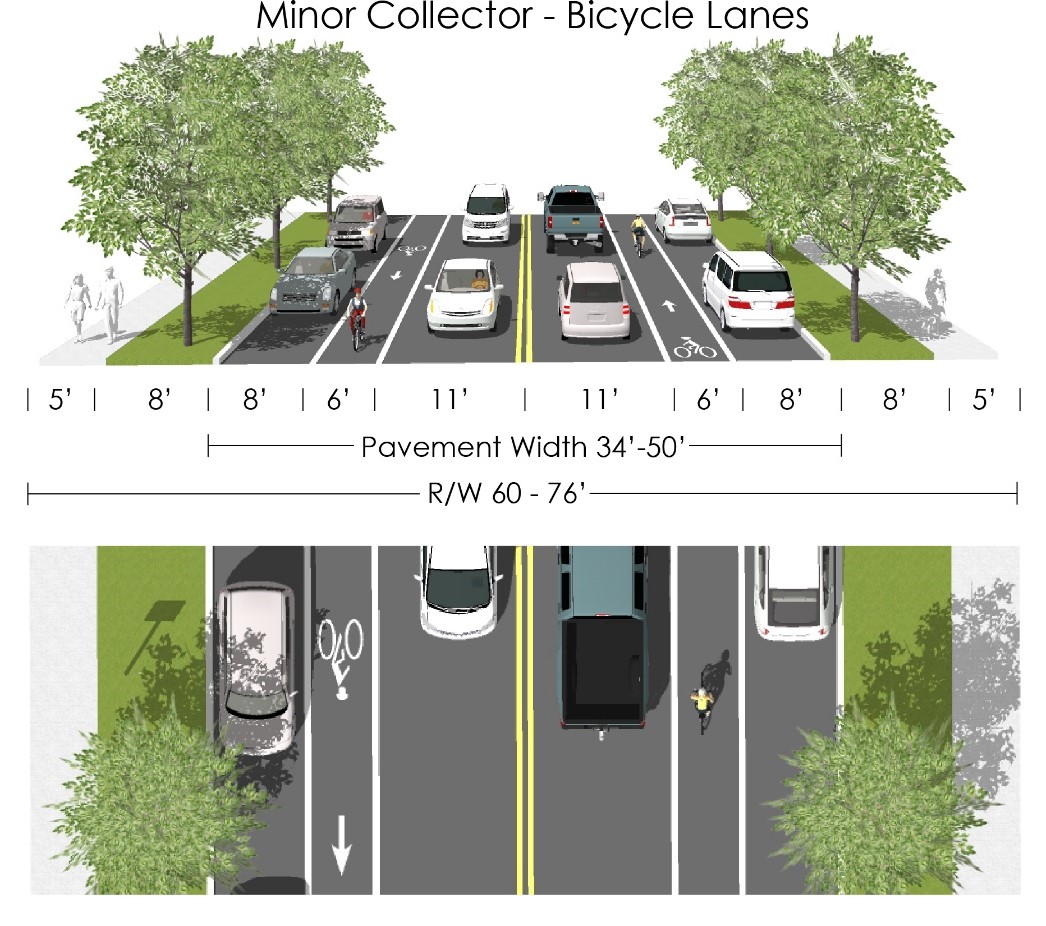10.428 Higher-Order Street Classification System.
All higher-order (major) streets within the City are classified in one of the following categories:
(1) Regional Arterial and Major Arterial Description. The regional arterial and major arterial classifications are primarily used for roadways with high traffic volumes and regional connections. Regional arterials have the same cross section as major arterials, but are intended to have greater access control to facilitate the movement of regional traffic. Both these classifications correspond to the Federal Highway Administration (FHWA) other principal arterial classification. Arterials are higher-order facilities that are generally intended to connect to several collector roadways or provide links to higher order interstate or highway facilities. One hundred feet of right-of-way is required for major arterials to allow construction of a five-lane roadway section, bicycle facilities, and detached sidewalks with a planter strip.
If a new regional or major arterial is built, the cross section with separated bicycle facilities under subsection (1)(a) of this section shall be used. The cross section shown under subsection (1)(d) of this section shall be used when a new regional or major arterial is built in downtown or other commercial/mixed use environments. For existing regional and major arterials, the use of this cross section shall be evaluated first before considering other cross sections. An applicant shall justify to the approving authority why the use of either of the other two cross sections is being requested.
Where right-of-way is constrained on existing roadways, flexibility may be provided to allow modifications, consistent with the legacy street standards in Section 10.427. The width of the planter strip is measured from the face of curb to the edge of the sidewalk, and shall be planted with trees identified on the City-approved street tree list. In cases where the planter strip is maintained by the City, the Parks Department shall approve the planting and irrigation plans prior to installation. Additionally, the median lane can be reduced to six feet if a two-foot wide raised median is built and is compatible with the area context and surrounding roadways as determined by the City Engineer. The planted center medians shown in the cross sections are for illustrative purposes. Landscaping is permitted in the center medians but not required. Proposals that include landscaped medians shall be coordinated with the Parks and Fire Departments to avoid obstructions that limit or restrict maintenance or emergency access or egress.
Examples of Regional Arterials in the City of Medford include North Phoenix Road and Foothill Road. Examples of Major Arterials include roads such as McAndrews Road and Barnett Road.
Regional, Major Arterial Cross-Sections. The following are the major/regional arterial cross-sections:
(a) Regional Arterial, Major Arterial, With Separated Bicycle Lanes. For use along regional and/or major arterial roadways when new and/or unimproved.
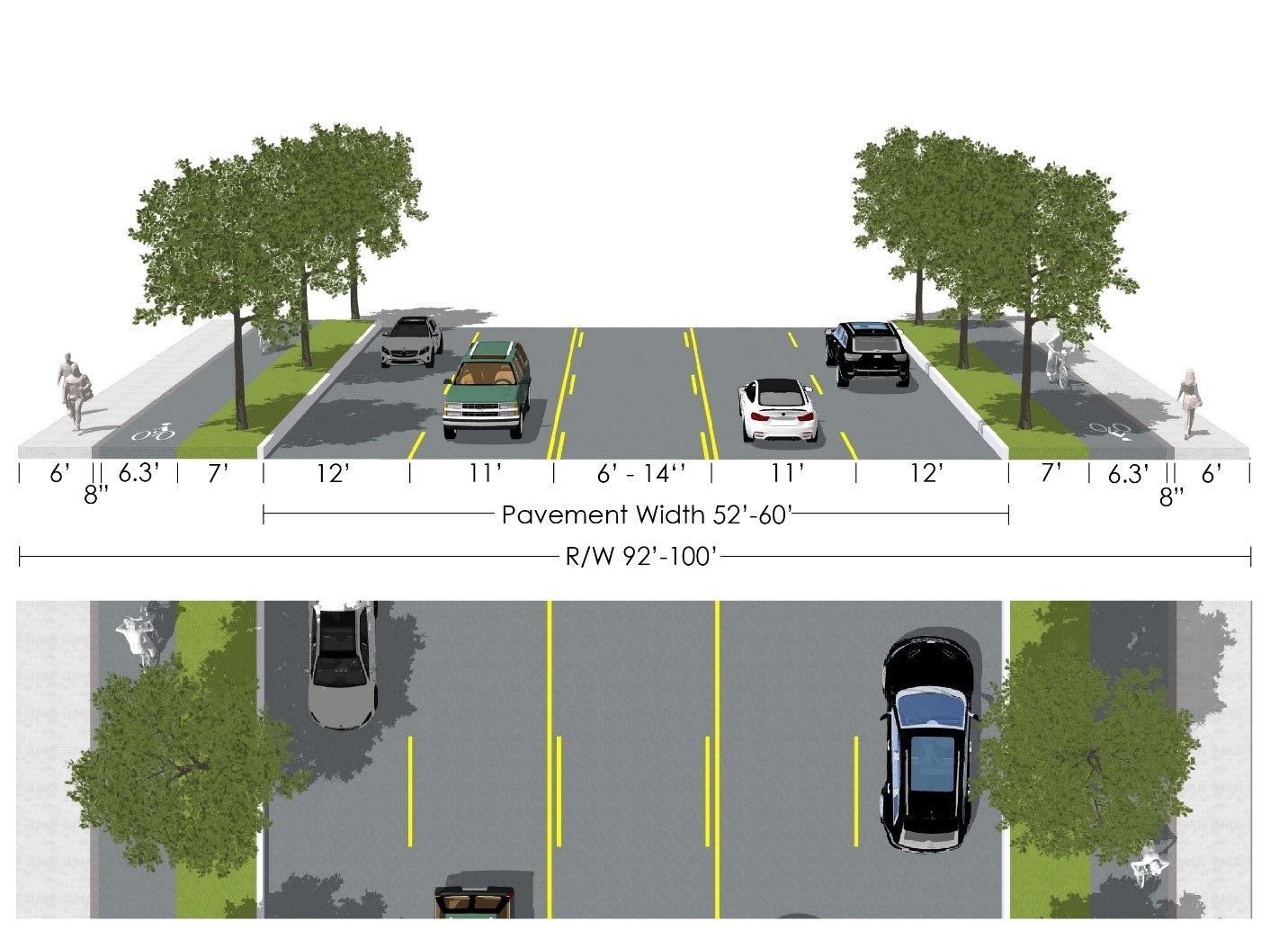
Notes:
1.Place trees, poles and other fixed objects in middle of planter strip.
2.Buffer between the bike path and the sidewalk shall be mountable curb.
3.Bike path may be a dark gray or black colorized concrete mix or asphaltic concrete. Color shall be integral to the concrete mix.
4.Trees in planter shall be on the City-approved street tree list and irrigation shall meet the Parks Department’s landscape and irrigation standards.
(b) Regional Arterial, Major Arterial, with Buffered Bicycle Lanes. For use along regional and/or major arterial roadways at the approving authority’s discretion.
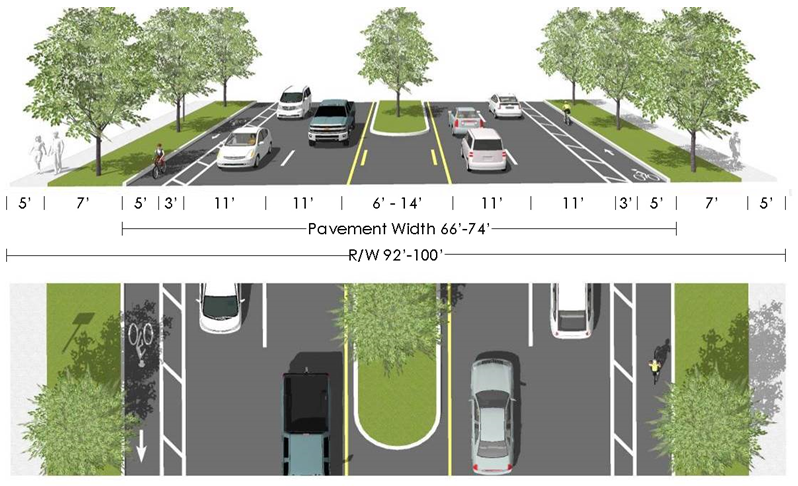
(c) Regional Arterial, Major Arterial, with Standard Bicycle Lanes. For use along regional and/or major arterial roadways with right-of-way constraints and with approving authority approval.
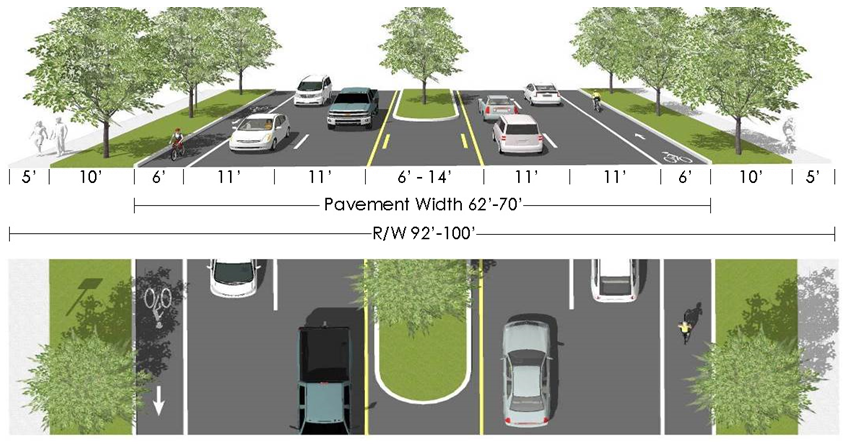
(d) Regional Arterial, Major Arterial, With Separated Bicycle Lanes (Commercial/Mixed Use Corridor Option). For use along regional and/or major arterial roadways when located in the downtown or other commercial/mixed use environment.

Notes:
1To be used in commercial or mixed-use corridors such as Barnett Road in the Southeast Village Commercial Center.
2Bike path may be a dark gray or black colorized concrete mix or asphaltic concrete. Color shall be integral to the concrete mix.
3Trees in furnishing zone shall be on the City-approved street tree list and irrigation shall meet the Parks Department’s landscape and irrigation standards.
(2) Minor Arterial Description. Minor arterials generally serve slightly lower traffic volumes than major arterials. Access to minor arterial streets is very limited. Where right-of-way is constrained on existing roadways, flexibility may be provided to allow modifications, consistent with the legacy street standards in Section 10.427. The width of the planter strip is measured from the face of curb to the edge of the sidewalk, and shall be planted with trees identified on the City-approved street tree list. In cases where the planter strip is maintained by the City, the Parks Department shall approve the planting and irrigation plans prior to installation. Street designs, including sidewalk width, planter strip use, and lane widths, may be adjusted through an adopted plan or modified code standards to create a “main-street” like atmosphere in locations such as downtown or transit-oriented districts. The planted center medians shown in the cross sections are for illustrative purposes. Landscaping is permitted in the center medians but not required. Proposals that include landscaped medians shall be coordinated with the Parks and Fire Departments to avoid obstructions that limit or restrict maintenance or emergency access or egress.
If a new minor arterial is built, the cross section with separated bicycle facilities under subsection (2)(a) of this section shall be used. The cross section shown under subsection (2)(d) of this section shall be used when a new minor arterial is built in downtown or other commercial/mixed use environments. For existing minor arterials, the use of this cross section shall be evaluated first before considering other cross sections. An applicant shall justify to the approving authority why use of one of the other cross sections is being requested.
Examples of Minor Arterials in the City of Medford include West Main Street and Kings Highway.
Minor Arterial Cross-Sections. The following are the minor arterial cross sections:
(a) Minor Arterial, With Separated Bicycle Lanes. For use along minor arterial roadways, when new and/or unimproved.
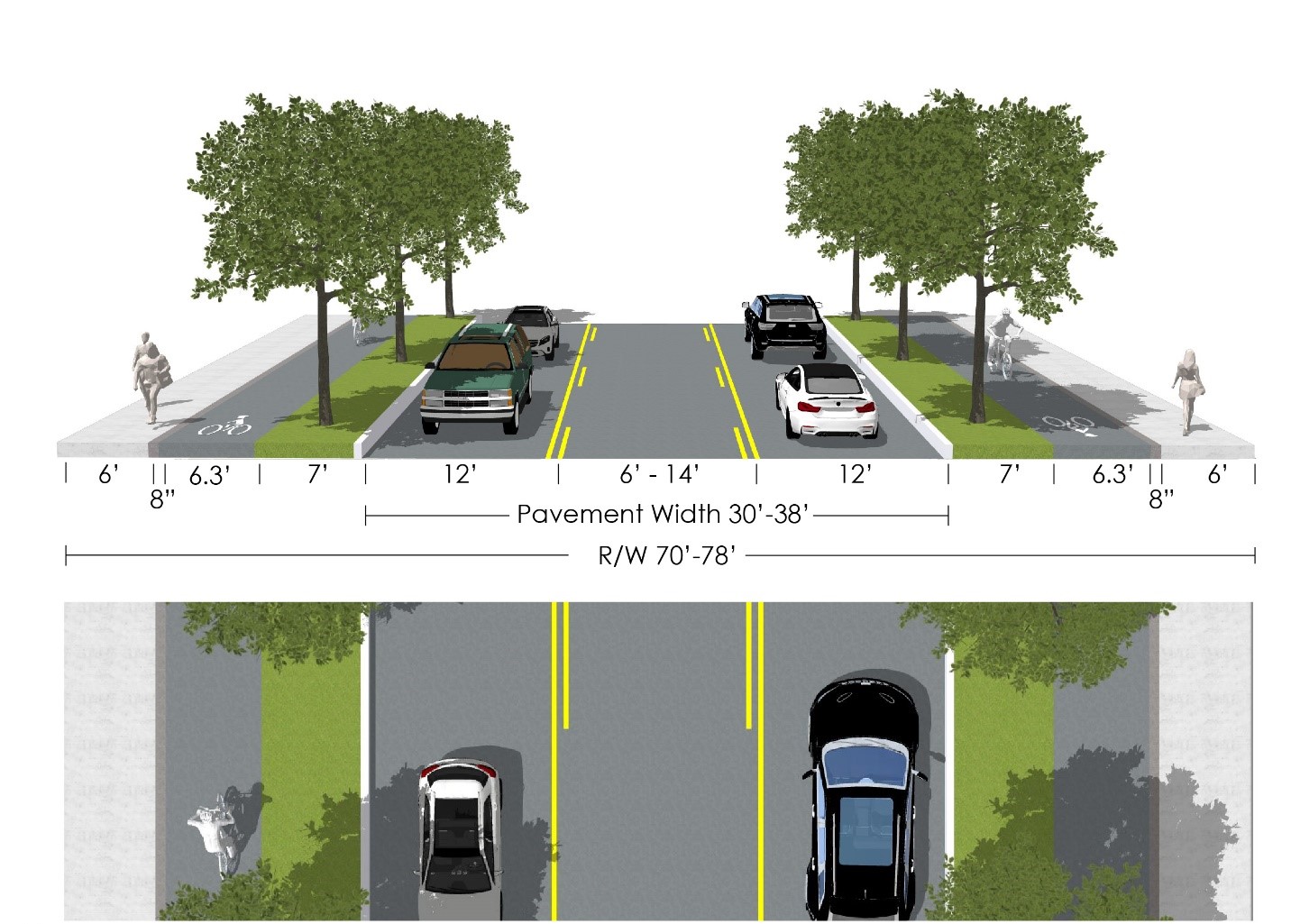
Notes:
1.Place trees, poles, and other fixed objects in middle of planter strip.
2.Buffer between the bike path and the sidewalk shall be mountable curb.
3.Bike path may be a dark gray or black colorized concrete mix or asphaltic concrete. Color shall be integral to the concrete mix.
4.Trees in planter shall be on the City-approved street tree list and irrigation shall meet the Parks Department’s landscape and irrigation standards.
(b) Minor Arterial, with Buffered Bicycle Lanes. For use along minor arterial roadways at the approving authority’s discretion.
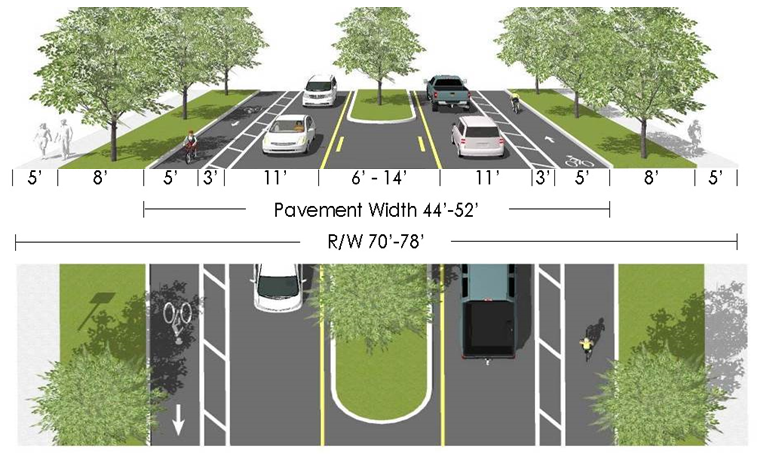
(c) Minor Arterial, with Standard Bicycle Lanes. For use along minor arterial roadways with right-of-way constraints and with approving authority approval.
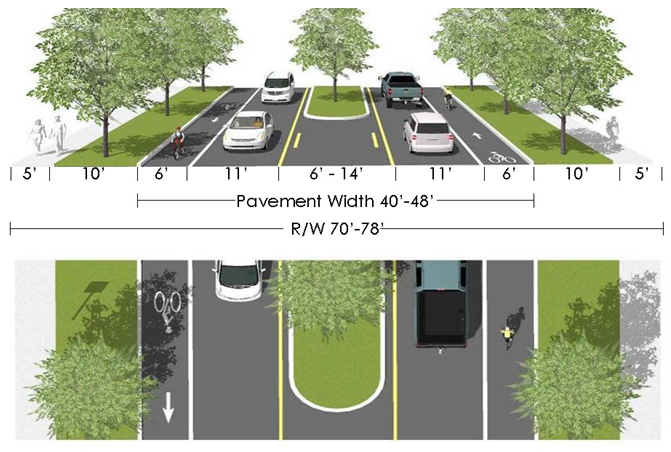
(d) Minor Arterial With Separated Bicycle Lanes (Commercial/Mixed Use Corridor Option). For use along minor arterial roadways when located in the downtown or other commercial/mixed use environment.
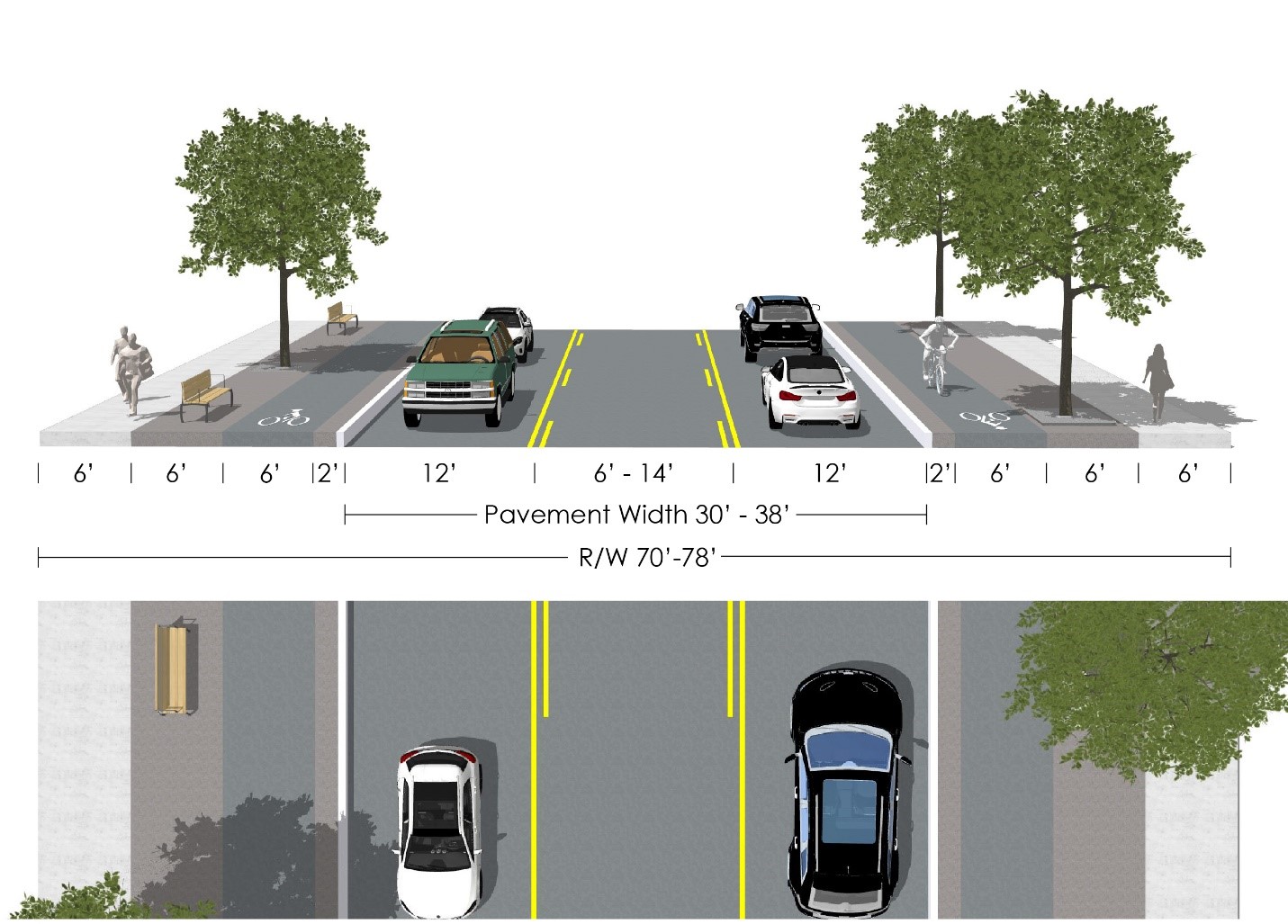
Notes:
1To be used in commercial or mixed-use corridors such as Barnett Road in the Southeast Village Commercial Center.
2Bike path may be a dark gray or black colorized concrete mix or asphaltic concrete. Color shall be integral to the concrete mix.
3Trees in furnishing zone shall be on the City-approved street tree list and irrigation shall meet the Parks Department’s landscape and irrigation standards.
(3) Major Collector Description. The Major Collector classification is used for streets that link arterial and lower-order streets and serve moderate traffic volumes. Collectors serve both mobility and access functions with a three-lane roadway section, bicycle lanes, and detached sidewalks with a landscaped planter strip. Within this classification on-street parking is not provided. Where right-of-way is constrained on existing roadways, flexibility may be provided to allow modifications, consistent with the legacy street standards in Section 10.427. The width of the planter strip is measured from the face of curb to the front edge of the sidewalk, and shall be planted with trees identified on the City-approved street tree list. In cases where the planter strip is maintained by the City, the Parks Department shall approve the planting and irrigation plans prior to installation. Street designs, including sidewalk width, planter strip use, and lane widths, may be adjusted through an adopted plan or modified code standards to create a “main-street” like atmosphere in locations such as downtown or transit-oriented districts. If designated as an Evacuation Route, per the Functional Classification Map in the adopted TSP, no raised median shall be constructed in the center turn lane. The planted center medians shown in the cross sections are for illustrative purposes. Landscaping is permitted in the center medians but not required. Proposals that include landscaped medians shall be coordinated with the Parks and Fire Departments to avoid obstructions that limit or restrict maintenance or emergency access or egress.
Examples of Major Collectors in the City of Medford include Lozier Lane, Hillcrest Road, Siskiyou Boulevard, Black Oak Drive, and Springbrook Road.
Major Collector Cross-Sections. The following are the major collector cross-sections:
(a) Major Collector, With Buffered Bicycle Lanes. For use along major collector roadways when new and/or unimproved.
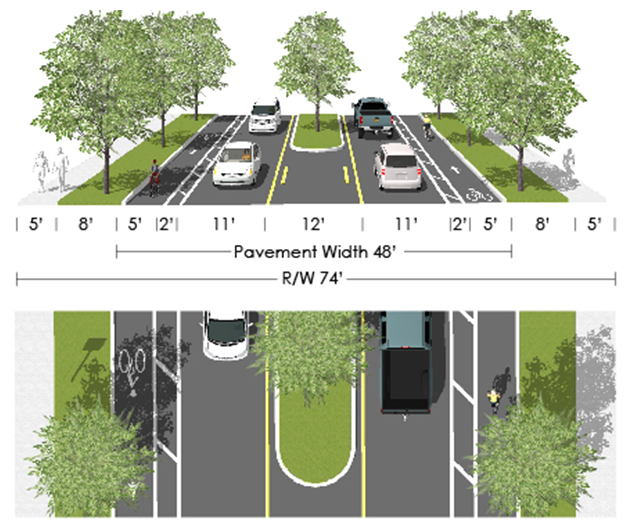
(b) Major Collector, with Standard Bicycle Lanes. For use along major collector roadways at the approving authority’s discretion.
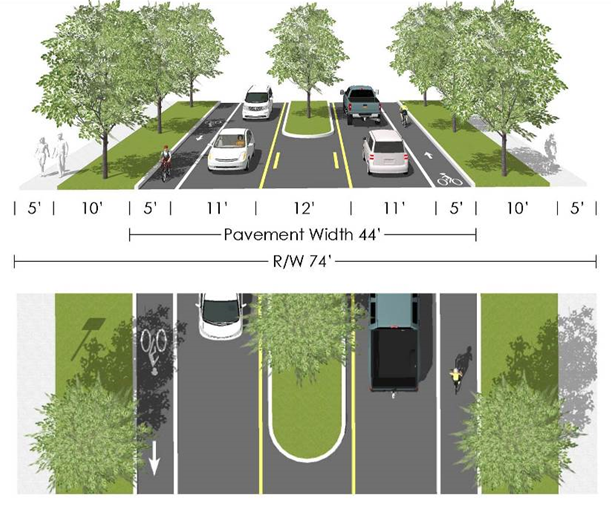
(4) Minor Collector Description. Minor collectors serve relatively low traffic volumes and place a greater emphasis on access rather than traffic flow as compared to major collectors. Most minor collectors run through neighborhoods and link residential streets to higher-order collectors and arterials. This classification includes a similar paved width to major collectors but includes on-street parking and no center turn lane. Where right-of-way is constrained on existing roadways, flexibility may be provided to allow modifications, consistent with the legacy street standards in Section 10.427. The width of the planter strip is measured from the face of curb to the front edge of the sidewalk, and shall be planted with trees identified on the City-approved street tree list. In cases where the planter strip is maintained by the City, the Parks Department shall approve the planting and irrigation plans prior to installation. Street designs, including sidewalk width, planter strip use, and lane widths, may be adjusted through an adopted plan or modified code standards to create a “main-street” like atmosphere in locations such as downtown or transit-oriented districts.
Special Note:
(i) Parking is not eligible for SDC credits, and is constructed at the developer’s expense; and
(ii) The range in pavement width accounts for the possibility of no on-street parking. When no on-street parking is constructed, right-of-way widths shall be adjusted.
Examples of Minor Collectors in the City of Medford include Oregon Avenue, Dakota Avenue, Holly Street and S. Oakdale Avenue.
Minor Collector Cross-Section. The following is the minor collector cross section:
(a) Minor Collector with Standard Bicycle Lanes. For use along minor collector roadways when new and/or unimproved.
